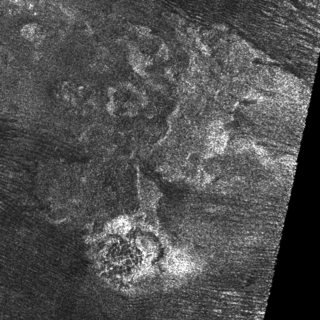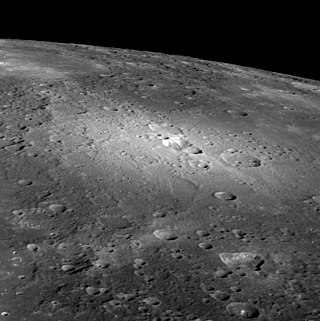Facula (pl.faculae) is a bright spot on the surface of a planet or a star. It may refer to
Facula (pl.faculae) is a bright spot on the surface of a planet or a star. It may refer to

Amalthea is a moon of Jupiter. It has the third closest orbit around Jupiter among known moons and was the fifth moon of Jupiter to be discovered, so it is also known as Jupiter V. It is also the fifth largest moon of Jupiter, after the four Galilean Moons. Edward Emerson Barnard discovered the moon on 9 September 1892 and named it after Amalthea of Greek mythology. It was the last natural satellite to be discovered by direct visual observation; all later moons were discovered by photographic or digital imaging.

A cryovolcano is a type of volcano that erupts volatiles such as water, ammonia or methane into an extremely cold environment that is at or below their freezing point. The process of formation is known as cryovolcanism. Collectively called cryomagma, cryolava or ice-volcanic melt, these substances are usually liquids and can form plumes, but can also be in vapour form. After the eruption, cryomagma is expected to condense to a solid form when exposed to very low surrounding temperatures. Cryovolcanoes may potentially form on icy moons and other objects with abundant water past the Solar System's snow line. A number of features have been identified as possible cryovolcanoes on Pluto, Titan and Ceres, and a subset of domes on Europa may have cryovolcanic origins. In addition, although they are not known to form volcanoes, ice geysers have been observed on Enceladus and potentially Triton.

Lyctos Facula is a bright mountain on one of Jupiter's smallest moons Amalthea. It is believed to have a width of 25 kilometers and height of 20 kilometers, almost two and a half times higher than Mount Everest . It is one of two named faculae that appear on Amalthea, the other being Ida Facula. It was discovered by Voyager 1 in 1979 and in the same year named for the region of Crete in which Zeus was raised. Firstly it was named simply Lyctos.

A plage is a bright region in the Sun's chromosphere, typically found in and around active regions. Historically, they have been referred to as bright flocculi, in contrast to dark flocculi, and as chromospheric faculae, in contrast to photospheric faculae.

Ceres, minor-planet designation 1 Ceres, is a dwarf planet in the middle main asteroid belt between the orbits of Mars and Jupiter. It was the first asteroid discovered on 1 January 1801, by Giuseppe Piazzi at Palermo Astronomical Observatory in Sicily and announced as a new planet. Ceres was later classified as an asteroid and then a dwarf planet, the only one always inside Neptune's orbit.

The Hokusai quadrangle (H-5) is one of fifteen quadrangles on the planet Mercury. It runs from 360 to 270° longitude and 20 to 70° latitude. Named after the Hokusai crater, it was mapped in detail for the first time after MESSENGER entered orbit around Mercury in 2011. It had not been mapped prior to that point because it was one of the six quadrangles that wasn't illuminated when Mariner 10 made its flybys in 1974 and 1975. These six quadrangles continued to be known by their albedo feature names, with this one known as the Apollonia quadrangle.

Matisse is an impact crater on the southern hemisphere of Mercury. Matisse takes its name from the French artist Henri Matisse, and it was named by the IAU in 1976.

Sotra Patera is a prominent depression on Titan, the largest moon of Saturn. It was formerly known as Sotra Facula; the current name was approved on 19 December 2012. It is a possible cryovolcanic caldera 30 km (19 mi) across and 1.7 km (1.1 mi) deep, and is immediately to the east of the largest putative cryovolcanic mountain on Titan, the 1.45 km (0.90 mi) high Doom Mons. Sotra Patera is the deepest known pit on Titan.

Kurosawa is a crater on Mercury. Its name was adopted by the International Astronomical Union (IAU) in 1976. Kurosawa is named for the Japanese composer Kinko Kurosawa, who lived in the 18th century CE.

Several bright surface features were discovered on the dwarf planet Ceres by the Dawn spacecraft in 2015.

Occator is an impact crater located on Ceres, the largest object in the main asteroid belt that lies between the orbits of Mars and Jupiter, that contains "Spot 5", the brightest of the bright spots observed by the Dawn spacecraft. It was known as "Region A" in ground-based images taken by the W. M. Keck Observatory on Mauna Kea.

Dantu is a large crater on Ceres, located within the Vendimia Planitia. It is rimmed by a number of minor faculae, which together form Bright Spot 2.
This is a list of space objects and features which were named after Filipino people and Philippine places.

Nathair Facula is a bright region on the surface of Mercury, located at 36° N, 295.5° W. It was named by the IAU in 2018. Nathair is the Irish word for snake.
Kepler-71 is a yellow main sequence star in the constellation of Cygnus.

Amaru Facula is a bright, irregular depression on the surface of Mercury, located at 49.8° S, 349.5° W. It was named by the IAU in 2018. Amaru is the Quechua word for snake.

Nākahi Facula is a bright, irregular depression on the surface of Mercury, located at 52.7° S, 342.2° W. It was named by the IAU in 2018. Nākahi is the Māori word for snake.